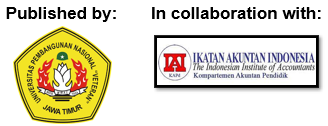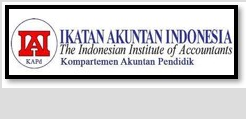Investigating the Effect of Liquidity, Leverage, Sales Growth, and Good Corporate Governance on Financial Distress
DOI:
https://doi.org/10.33005/jasf.v2i2.49Keywords:
Financial Distress, Liquidity, Leverage, Sales Growth, Good Corporate GovernanceAbstract
Large companies may experience financial distress because of their inability to compete. Therefore, investors should be more vigilant in investing their funds. Some ways that can be done is through cash flow analysis, analysis of corporate strategy, and analysis of financial statements. This study aims to determine the effect of liquidity, leverage, sales growth, and good corporate governance on financial distress. The study used 55 samples of telecommunication and non-construction companies listed in Indonesia Stock Exchange period 2013-2017. The technique sampling in this study is the purposive sampling method. The data analysis method is PLS (Partial Least Square). The results of this study indicate that liquidity, leverage, sales growth, and good corporate governance do not affect financial distress. These unexpected results may due to the limitation of this study. Therefore, for future research in financial distress, it is suggested to take into account the sample size and other variables that expected to affect financial distress.
Downloads
References
Africa, L.G. (2019). Financial Distress Prediction Using Rgec Model on Foreign Exchange Banks and Non-Foreign Exchange Banks, Journal of Accounting and Strategic Finance, 2 (1), 48-55. DOI : https://doi.org/10.33005/jasf.v2i1.34
Al-khatib, H. B. & Alaa Al-Honari. (2012). Predicting Financial Distress of Public Companies Listed in Amman Stock Exchange. European Scientific Journal. Vol 8. No 15, 1-17.
Almalia, L. S. & Kristijadi. (2003). Analisis Rasio Keuangan Untuk Memprediksi Kondisi Financial Distress Perusahaan Manufaktur Yang Terdaftar Di Bursa Efek Jakarta. JAAI. Vol 7. No 2, 183-210.
Andre, O. & Taqwa, S. (2014). Pengaruh Profitabilitas, Likuiditas, dan Leverage Dalam Memprediksi Financial Distress. Jurnal WRA. Vol 2 No 1, 294-312.
Ayu, A. S., Handayani, S.R., & Topowijono (2017). Pengaruh Likuiditas, Leverage, profitabilitas, dan Ukuran Perusahaan Terhadap Financial Distress. Jurnal Administrasi Bisnis (JAB). Vol 43. No 1, 138-147.
Cinantya, P. I. G. A. A. & Merkusiwati, N. K. L. A. (2015). Pengaruh Corporate Governance,
Financial Indicators, dan Ukuran Perusahaan Pada Financial Distress. E-Jurnal Akuntansi Universitas Udayana. Vol 10 No 3, 897-915.
Fachrudin, K. A. (2011). Analisis Pengaruh Struktur Modal, Ukuran Perusahaan, dan Agency Cost Terhadap Kinerja Perusahaan. Jurnal Akuntansi dan Keuangan. Vol 13. No 1, 37-46.
Fathonah, A. N. (2016). Pengaruh Penerapan Good Corporate Governance terhadap Financial Distress. Jurnal Ilmiah Akuntansi.Vol 2. No 1, 133-150.
Fathoni, A.F., Haryetti, Wijaya E.Y., & Muchsin, (2014). The Effect of Good Corporate Governance Mechanism, Financial Distress on Earning Management Behavior: Empirical Study in Property and Infrastructure Industry in Indonesian Stock Exchanges, Jurnal Ekonomi, 22 (1), Maret, 1-16.
Kasmir (2008). Analisis Laporan Keuangan. Jakarta:PT Raja Grafindo Persada.
Kistini, D. S. & Nahumury, J. (2014). The Effect of Public Accounting Firm Size, Financial Distress, Institutional Ownership, and Management Change on The Auditor Switching in Manufacturing Companies Listed in Indonesia Stock Exchange. The Indonesian Accounting Review. Vol 4. No 2, 185-194.
Ochieng, O.S.P. (2018). Factors Contributing to Financial Distress in CommercialBanks of Kenya, The International Journal of Business Management and Technology, Volume 2 Issue 5, September-October, 135-150.
Putri, N. W. K. A. & Merkusiwati, N. K. L. A. (2014). Pengaruh Mekanisme Corporate Governance, Likuiditas, Leverage, dan Ukuran Perusahaan Pada Financial Distress. E-Jurnal Akuntansi Universitas Udayana. Vol 7. No 1, 93-106.
Tempo.co, (2015). Skenario Bisnis Bakrie Telecom Meski Merugi, 11 March, https://bisnis.tempo.co/read/648974/skenario-bisnis-bakrie-telecom-meski-merugi, accessed 08 December 2017).
Thim, C. K., Choong, Y.V., & Nee, C.S. (2011). Factors Affecting Financial Distress: The Case of Malaysian Public Listed Firms, Corporate Ownership and Control, 8 (4), 345-351. DOI:10.22495/cocv8i4c3art3.
Wang, Ma-Ju & Shiu, Heng-Ruei, (2014). Research on the common characteristics of firms in financial distress into bankruptcy or recovery, Investment Management and Financial Innovations, Volume 11, Issue 4, 233-243.
Widarjo, W. & Setiawan, D. (2009). Pengaruh Rasio Keuangan Terhadap Kondisi Financial Distress Perusahaan Otomotif. Jurnal Bisnis Dan Akuntansi. Vol 11. No 2, 107-119.
Widhiari, N. L. M. A. & Merkusiwati, N. K. L. A. (2015). Pengaruh Rasio Likuiditas, Leverage, Operating Capacity, dan Sales Growth Terhadap Financial Distress. E-Jurnal Akuntansi Universitas Udayana. Vol 11. No 2, 456-469.














